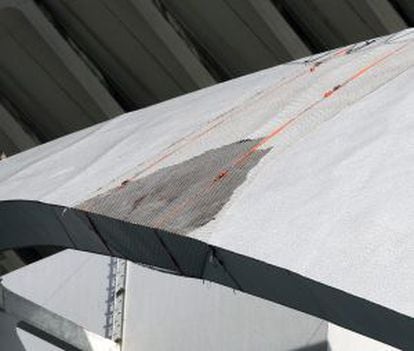Calatrava’s opera house: a rip-off?
It will cost millions to remove mosaics from the facade of the Palau de les Arts


The job is something akin to "tiling the hull of a ship, it's very complicated." So complicated, in fact, that authorities have decided to simply rip off the 8,000 square meters of trencadís (a ceramic mosaic made from tile shards, first used by Gaudí and other Catalan modernists) covering the enormous façade of the Palau de les Arts in Valencia.
The performing arts center and opera house was designed by the prominent architect Santiago Calatrava, who also created New York's World Trade Center Transportation Hub, scheduled to open in 2015, as well as many other international projects. His work is known for its airy, curved designs that suggest a symbiosis between architecture and sculpture. It has also proven controversial in recent years because of ballooning budgets and technical glitches.
The Palau, which cost 478 million euros to build, opened eight years ago. A recent analysis by the Construction Technology Institute (Aidico) concluded that there is a "generalized failure of the ceramic covering's adherence" on 60 percent of the surface. The Valencian government commissioned this report after a section of the mosaic fell off on December 26, forcing the opera house to shut down and cancel performances.

When all the tiles are pulled off the Palau, which is part of the landmark City of Arts and Sciences complex, the exposed steel dome will be painted white, making it look like a ship that ran aground, to borrow the nautical simile from Máximo Buch, the Valencian economy commissioner who described the building's problems.
The problem is caused by a "faulty design and selection of materials, or a faulty execution, or both," reads the preliminary report. To complicate matters further, the metal dome and the ceramic covering have different coefficients of thermal expansion and they are subjected to notable temperature changes, all of which has resulted in lumps and wrinkles forming visibly on the façade.
Several experts consulted by this newspaper nearly a year ago had already warned that this was a serious problem.
The Aidico report notes that the same trencadís that covers concrete surfaces inside the Palau "does not present any problems." But the experts conclude that the outer damage is "irreversible" and that immediate action must be taken.
Yet the Palau has become an icon of the cityscape and a movie setting
Ripping off the tiles will cost an estimated three million euros. To this figure must be added the 624,000 euros that were lost following the cancellation of Puccini's opera Manon Lescaut, which was going to be directed by Plácido Domingo beginning on February 1.
Commissioner Buch said that the Valencian government will advance the money for the repair work, then claim it back from the architect Calatrava, the builders Dragados and Acciona, and the engineering consultancy Intemac. The Valencian attorney's office is already working on official complaints against all parties involved.
For now, the goal is to resume the opera performances on February 23 with Rossini's L'italiana in Algeri. Authorities have already hired a work crew to bring in their picks and extend a safety net around the building to protect public access on the south side, the sunniest and most badly affected by the wrinkles.
Buch also noted that Calatrava had phoned him the day before, marking the first time he did so since the Palau tile controversy first broke out months ago. The star architect spoke in conciliatory tones and was willing to find a solution to the problem, said the Valencian official, who would not say whether Calatrava was blaming it on the design or the construction.
This is the third major crisis at the Palau de les Arts. First the performing stage caved in, then the entire premises were flooded below the level of the former riverbed of the Turia river, where it is located.
Even its construction was controversial because of the ballooning costs. Calatrava's studio charged 44 million euros for designing and directing the building work. When the center was inaugurated, it turned out that dozens of seats had obstructed views of the stage.
Yet at the same time the Palau has become an icon of the Valencia cityscape and a setting — along with the rest of the City of Arts and Sciences — for futuristic commercials and movies. The latest example is Tomorrowland, starring George Clooney, who is set to begin shooting here later this month.
‘Trencadís’ and footing the bill
That Santiago Calatrava's work is controversial is not news. But the rejection that much of his work causes among fellow architects (who write it off as "sculptural," though this attitude is generally said to be nothing more than envy), takes on an added dimension now that so many of his buildings have obviously run too many risks for the taxpayers' pockets.
This risk-taking, which was viewed as audacity back when the architect was on the politicians' good side, has ultimately resulted in claims, often initiated by Calatrava himself for financial reasons (as in the Oviedo Convention Center) or because of disputes over artistic authorship (the Zubizuri footbridge in Bilbao).
But the complaints underscore the reiterative nature of some of the problems. Calatrava keeps having trouble with his use of similar materials, notably the glassy, slippery floors of the bridges he designed in Bilbao, Murcia and Venice. Or else he keeps yielding to the temptation of showing off his technical skills by adding movement to the Oviedo convention center or the New York transportation hub only to have them ultimately remain static and incur in serious cost overruns.
And so Calatrava's recurring problems evidence the fact that architecture has ceased to be a matter of formal and technical experimentation. The real challenge these days is to accept the obligation to use public money responsibly. And this challenge must be accepted equally by the building companies -- who should know what can and cannot be built -- by the architect and by the politicians who allowed the senselessness to go on.
Gaudí's trencadís (mosaic work) never fell off, and the world is full of splendid examples of buildings covered with ceramic tiles that effortlessly withstand temperature changes, from the Sydney Opera House to the Santa Caterina de Miralles-Tagliabue market in Barcelona.
Still and all, with regard to this new setback for Calatrava, the bad news is also the good news. The fact that the Valencian government is daring to file a complaint against him should mean that it also dares to be transparent without fear of anybody speaking out about the commissions that have been the defining trait of Spain's architectural bubble.
Paradoxically, claiming those rights might be just the thing to return some credibility and confidence to a profession that has been hard hit by the actions of a few. It may be true that risk-taking is the only way to move forward at the technical and even the artistic level, but social progress can only come about by accepting responsibility. The architect, the builders and the politicians must solve this problem, and make it clear who is going to foot the bill.










































